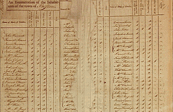|
|
|
 |
|
|
Germans in America > Genealogical Research |
|
Nearly
43 million Americans about 1-in-6 U.S. residents identified their ancestry
as German in the Census 2000. As opposed to first and second-generation
Americans, for whom integration and Americanization was of primary interest,
more recently third, fourth and later generations have shown an awakening
and increasing ethnic consciousness and concern in tracing their family
history back to its European origins. Also Germans are becoming increasingly
curious about whether they might have relatives across the Atlantic. Several important steps should be taken at home before traveling abroad. It will be useful to write out a family tree diagram, working backwards from yourself and your immediate family. In order to establish the exact points of origin in Germany of your ancestors who migrated to the New World, it may be necessary to consult both personal and public documents. After writing down the information handed down by oral traditions in the family, it must be verified - and often corrected - by written records. Vital statistical material is to be found in old family Bibles, which used to be handed down from father to son, and which were used to record important family dates such as births, baptisms, marriages, deaths and burials. Similar data can be found in diaries and old letters, on old photographs, on tombstones, and in military records. Certificates of Naturalization often give the date of entry into the United States and sometimes the name of the vessel on which the immigrant arrived. The ports of departure for immigrants from Germany were either Bremen, Bremerhaven, Cuxhaven or Hamburg. The ports of arrival for most immigrants from Germany were Philadelphia, New York, Baltimore and New Orleans.The name of the ship, the date of arrival, and the original family name of the immigrant can often be clues leading to ascertaining the place of origin, which may be recorded on various public documents. The most important sources of data on immigration are now on file in the National Archives in Washington, D.C. Passenger Lists. Beginning in 1820 each captain bringing in a ship to the chief ports in the United States was required on oath to record the names of his passengers, their sex, age, occupation, country of nativity and destination. This manifest was kept at the port of entry for many years, but a few years ago these manifests were deposited in the National Archives in Washington, D.C. Most of them have been microfilmed and those for New York, Boston, New Orleans, Philadelphia and Baltimore are available in the National Archives, some are also available online. Census Records. The Federal Census for the years 1850, 1860, 1870 and 1880 are available on microfilm. It is possible to consult them in the National Archives or have parts of them copied at a fixed price. The 1850 Census was the first Federal Census to give the birthplace of the persons enumerated. The 1880 Census also lists the nationality of the father and mother of the person enumerated. These lists are an excellent source if one knows the residence of the person sought. U.S Naturalization Records. Registers listing foreigners who became U.S. citizens are not to be found in a central depository. They are scattered throughout the country in the courts - municipal, district and federal. They often give valuable information about the individual's birthplace, date of arrival in the United States, and sometimes the name of the vessel on which he arrived. The naturalization records for the New England states are now available in the National Archives in Washington, D.C. Vital Records. While the registration of births, marriages and deaths shows a great unevenness throughout the country - some communities having waited until the beginning-of the present century before recording vital statistics - there are a number of communities which have records going back to the 19th century. Death certificates can be very important since they often give birth date and birthplace as well as next of kin. These records are to be found in local city halls or county courthouses. In some states the records have been centralized in the state capital. (see:: Where to Write for Vital Records ) Other public records that might be helpful are military records, land deeds, church books and city directories.
|
||
| Texts
are abridged from U.S. State Department IIP
publications and other U.S. government materials. |
||
| What
kind of information materials are available?
CD: These documents are available in fulltext format on the About the USA CD-ROM. Teachers: Request a copy for classroom use. L: Selected documents are available in German as well as other languages, including Arabic, Chinese, French, Spanish, Persian and Turkish. |
DISCLAIMER
Any reference obtained from this server to a specific commercial product, process, or service does not constitute or imply an endorsement by the United States Government of the product, process, or service, or its producer or provider. The views and opinions expressed in any referenced document do not necessarily state or reflect those of the United States Government. |
 U.S. Diplomatic Mission to Germany /Public Affairs/ Information Resource Centers Updated: March 2010 |
